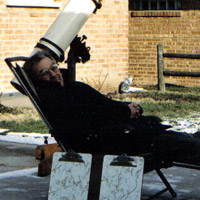Robert H. Hays, Jr. was born in 1950 and has always lived in the Chicago area. He became interested in astronomy as a boy, which he ascribes as “probably out of curiosity for natural phenomena. He began watching meteors during the 1960’s; especially vivid in his memory is a brilliant Perseid fireball in 1965. The Chicago light pollution exploded in the 1960s and ‘70s, and most of his observing involved the moon, lunar occultations, and planets.
His best meteor observing began in 1976 when he began watching in darker semi-rural sites. The first of these watches was on January 4, 1976 when he saw 33 Quadrantids in one hour with the temperature at –2 degrees F. It is no surprise that the Perseids have been his biggest draw; he saw an excellent display in 1980, with rates of about 80/hr. He saw several other good displays during the eighties, but states, “…the August weather has been mostly poor since then.” Most of his recent success with the Perseids has been due to traveling in search of better weather – a meteor observer tradition for many of us!
His observing is often catch-as-catch can, due to variable weather. As a result, he is often found out on nights with no major showers. A true meteor aficionado, Robert will often go out “just to see what meteors there are – and sometimes I’m pleasantly surprised! There are often night sounds that add to the ambiance. Depending on the season and locale there are owls, peepers, whip-or-whills, crickets, and other sounds that I can’t always identify.”
Most of Robert’s meteor observing is done at the various Indiana Fish & Wildlife areas just across the state line from Illinois. “They have decent skies despite being less than 75 miles south of Chicago. I do occasionally go on camping trips in rural areas and mix in some meteor observing, so I have observed at a variety of sites.”
Robert loves the simplicity of meteor observing. “I just need a chaise lounge, blanket, notebook, or clipboards. Most of the time he just counts meteors and gathers basic data. He only plots when low meteor activity is expected; even then he sometimes gets more than he bargained for! A useful “invention” for making things easier in the field is a “meteor board” consisting of two clipboards attached to a piece of paneling.
The short-wave radio is often used for timekeeping “since checking a watch can take longer than plotting.” .” He uses a tape recorder for strong sessions – “…absolutely essential during the 2001 Leonid display.” At that shower’s peak, he averaged about 8/minute with spikes to about 12/minute “despite it being a humid night with a fog threat – it clouded over shortly afterward. I saw more meteors that night than I have ever seen in a year!
You should be able to spot Robert’s “meteor board” in the photo, with his telescopes in the background. Robert uses large framed-glasses while observing to see more of the sky, but he’s only mildly myopic. Still, he sees the stars best when wearing them. Having recently retired from the U.S. Postal Service after 32 ½ years, Robert plan on observing for as long as he can!
 American Meteor Society
American Meteor Society
